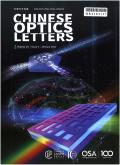面向表面增强拉曼光谱的方位矢量光束照射等离子体尖端圆簇
IF 2.8
2区 物理与天体物理
Q2 OPTICS
引用次数: 1
摘要
具有强电场近场增强的贵金属纳米结构可以显著改善纳米尺度的光-物质相互作用,是高灵敏度表面增强拉曼光谱(SERS)的关键。本文利用方位矢量光束(AVB)照射等离子体尖圆簇(PTCC)阵列,增强PTCC阵列的近场电场强度,进而提高SERS灵敏度。采用自组装法和电感耦合等离子体(ICP)刻蚀法制备了PTCC阵列。计算结果表明,与线极化束(LPB)和径向矢量束(RVB)激励相比,AVB激励由于相邻等离子体尖端之间的纳米间隙形成强烈的共振响应,可以获得更强的近场电场增强。随后,我们的实验结果证明,AVB激发使SERS灵敏度提高到10 -13 M,比LPB激发提高了2个数量级。同时,PTCC阵列具有优异的均匀性,拉曼增强因子计算为~ 2.4× 10 8。这种矢量光场增强拉曼光谱技术可以应用于传感技术领域,如超低浓度的痕量检测。本文章由计算机程序翻译,如有差异,请以英文原文为准。
Azimuthal vector beam illuminating plasmonic tips circular cluster for surface-enhanced Raman spectroscopy
Noble metallic nanostructures with strong electric near-field enhancement can significantly improve the nanoscale light-matter interactions and are critical for high-sensitivity surface-enhanced Raman spectroscopy (SERS). Here, we use azimuthal vector beam (AVB) to illuminate the plasmonic tips circular cluster (PTCC) array to enhance the electric near-field intensity of the PTCC array, and then use it to improve SERS sensitivity. The PTCC array were prepared based on the self-assembled and Inductive Coupled Plasmon (ICP) etching methods. The calculation results show that, compared with linearly polarized beam (LPB) and radial vector beam (RVB) excitations, the AVB excitation can obtain stronger electric near-field enhancement due to the strong resonant responses formed in the nanogap between adjacent plasmonic tips. Subsequently, our experimental results proved that AVB excitation increased SERS sensitivity to 10 -13 M, which is 2 orders of magnitude higher than that of LPB excitation. Meanwhile, the PTCC array had excellent uniformity with Raman enhancement factor calculated to be ∼ 2.4× 10 8 . This kind of vector light field enhancing Raman spectroscopy may be applied in the field of sensing technologies, such as to the trace examination with ultra-low concentration.
求助全文
通过发布文献求助,成功后即可免费获取论文全文。
去求助
来源期刊

Chinese Optics Letters
物理-光学
CiteScore
5.60
自引率
20.00%
发文量
180
审稿时长
2.3 months
期刊介绍:
Chinese Optics Letters (COL) is an international journal aimed at the rapid dissemination of latest, important discoveries and inventions in all branches of optical science and technology. It is considered to be one of the most important journals in optics in China. It is collected by The Optical Society (OSA) Publishing Digital Library and also indexed by Science Citation Index (SCI), Engineering Index (EI), etc.
COL is distinguished by its short review period (~30 days) and publication period (~100 days).
With its debut in January 2003, COL is published monthly by Chinese Laser Press, and distributed by OSA outside of Chinese Mainland.
 求助内容:
求助内容: 应助结果提醒方式:
应助结果提醒方式:


